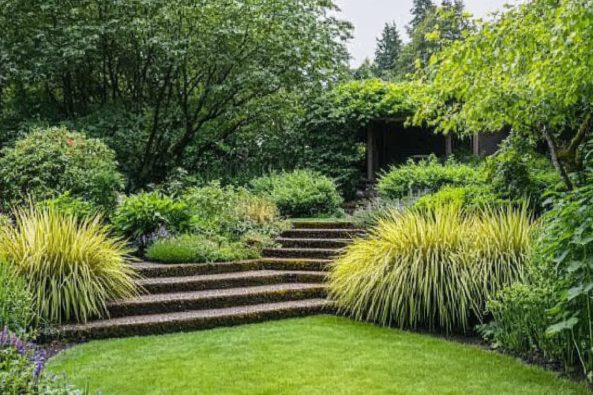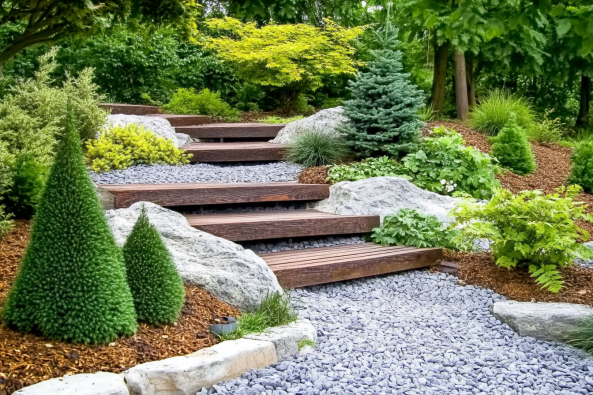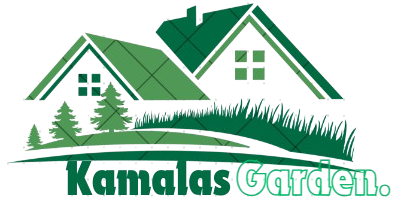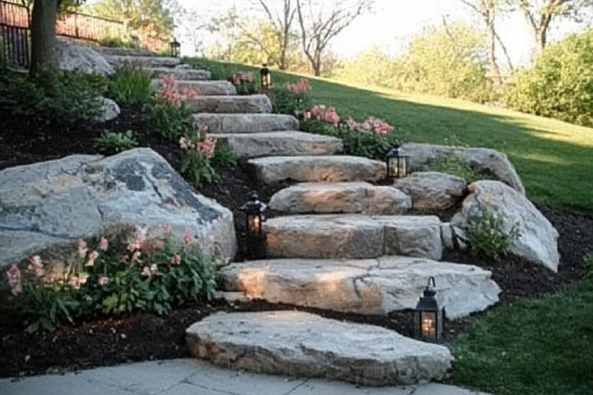Challenges of Hillside Landscaping
Landscaping on a hillside comes with unique challenges that require careful planning and strategic solutions. Here are some of the key issues that homeowners face when dealing with sloped terrain:
Soil Erosion Risks
Slopes are highly susceptible to erosion, especially during heavy rains. Without proper ground cover or reinforcement, soil can wash away, damaging plants and landscape features.
Water Drainage Issues
Water runoff can become problematic, leading to soil displacement and poor irrigation. Proper drainage solutions, such as drip irrigation or terracing, are necessary to keep the landscape healthy.
Difficulty in Mowing and Maintenance
Steep inclines make mowing challenging and unsafe. Reducing lawn areas or incorporating alternative landscaping techniques can save time and effort while maintaining an attractive yard.
Best Low-Maintenance Landscaping Ideas for Slopes
1. Ground Cover Cascade

Ground cover plants are a fantastic low-maintenance solution for hillsides. They help prevent soil erosion and require minimal upkeep.
- Best Low-Maintenance Ground Cover Plants: Creeping phlox, sedum, juniper, and vinca minor.
- How Ground Covers Help Prevent Erosion: Their roots hold the soil in place, reducing runoff and stabilizing slopes naturally.
2. Terraced Planting Landscape
Terracing transforms steep slopes into manageable garden spaces, improving aesthetics and functionality.
- Benefits of Terracing for Slope Stabilization: Reduces erosion, enhances water retention, and creates visually appealing layers.
- Plant Choices for Tiered Gardens: Ornamental grasses, drought-tolerant perennials, and shrubs like lavender and rosemary.
3. Rock Garden Serenity
Rock gardens provide a natural, attractive solution that requires little maintenance.
- Using Rocks for a Natural, Low-Maintenance Look: Rocks anchor the soil, reduce watering needs, and add texture.
- Drought-Resistant Plants for Rock Gardens: Succulents, yarrow, Russian sage, and creeping thyme.
4. Native Plant Haven
Native plants thrive in local conditions, reducing the need for extra watering or fertilization.
- Why Native Plants Are Ideal for Sloped Landscapes: They adapt to the climate and require minimal care.
- Top Native Plants That Require Minimal Care: Coneflower, switchgrass, wild geranium, and goldenrod.
5. Drip-Irrigated Gradient
A drip irrigation system ensures efficient water use on sloped terrain.
- Benefits of Drip Irrigation for Slopes: Provides slow, consistent moisture directly to roots, reducing runoff.
- Setting Up an Easy, Water-Efficient System: Install a gravity-fed or pressure-regulated system to distribute water evenly.
6. Retaining Walls & Steps for Stability
Retaining walls enhance both function and beauty in hillside landscapes.
- Using Retaining Walls to Prevent Soil Erosion: Stone or concrete walls hold back soil, creating stable terraces.
- Creating Natural Stone Steps for Access: Stone steps make navigating the slope safer and more convenient.
7. Mulch & Gravel for Weed Control

Mulching and gravel pathways offer aesthetic appeal and practicality.
- Best Mulch Types for Slope Coverage: Bark mulch, wood chips, and pine straw retain moisture and suppress weeds.
- Using Decorative Gravel for Pathways & Aesthetics: Gravel reduces erosion and provides stylish, maintenance-free walkways.
Additional Tips for a Low-Maintenance Hillside Landscape
Choosing Drought-Resistant Plants
Opt for plants that thrive in dry conditions to minimize watering needs. Examples include lavender, sedum, and ornamental grasses.
Avoiding Invasive Species
Some fast-growing plants can quickly overtake a slope, leading to extra maintenance. Research plant choices to avoid aggressive spreaders.
Minimizing Lawn Areas for Less Upkeep
Replacing grassy areas with ground covers, mulch, or rock gardens significantly reduces the need for mowing and watering.
Common Mistakes to Avoid in Hillside Landscaping
Overwatering and Poor Drainage Solutions
Improper irrigation can lead to erosion or plant damage. Use drip irrigation and well-placed drainage solutions.
Planting High-Maintenance Species
Avoid species that require frequent trimming, fertilization, or specialized care.
Failing to Address Soil Erosion Early
Ignoring erosion problems can lead to significant landscape damage. Implement ground covers, retaining walls, or terracing as early as possible.
More Low-Maintenance Landscaping Ideas
Alternatives to Grass for Sloped Areas
Explore options like wildflower meadows, moss gardens, or clover instead of traditional grass.
Best Shrubs for Sloped Landscapes
Shrubs such as boxwood, juniper, and dwarf hydrangeas provide low-maintenance beauty and erosion control.
Using Hardscaping for a Functional Hillside
Incorporate features like stone steps, gravel pathways, and retaining walls to reduce maintenance and improve accessibility.
Related Articles
- DIY Retaining Walls for Slopes
- How to Prevent Erosion in Your Backyard
- Easy Plants for Low-Maintenance Landscaping
By implementing these low-maintenance hillside landscaping ideas, you can create a beautiful, functional outdoor space with minimal effort!

